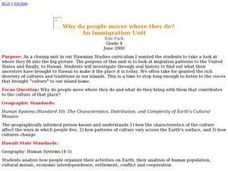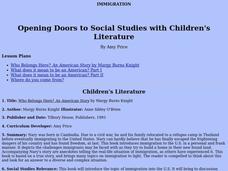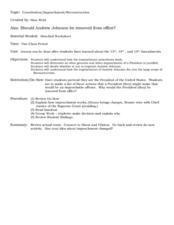Curated OER
Why do people mover where they do?
Young scholars read factual stories of migration to Hawaii, analyze and explain push and pull factors, interview parents about their cultural heritage, identify countried of origin of their ancestors, graph migration patterns on an world...
Curated OER
The Welcome Wagon
Students demonstrate an understanding of the immigrant experience in their state. In this immigrant lesson, students listen to immigrant speakers to their state and what their lives were like. Students write brief reports or complete...
Curated OER
A Comparative Look at Migrations
Students explore and compare and contrast the migrations of African Americans in the United States in the decades before and after the Civil War.
Humanities Texas
A President's Vision: Lyndon Baines Johnson
Learners take a closer look at the presidency of Lyndon B. Johnson, including the Great Society and the passage of the Voting Rights Act, through image analysis and primary source worksheets.
Curated OER
Injustice on Our Plates: Immigrant Women
Young scholars investigate the plight of undocumented workers. In this social justice lesson plan, students research undocumented workers as well as consumer boycott movements and write about their impressions.
Curated OER
We Have Rights
Students investigate the concept of having rights as citizens. In this citizenship lesson, students examine the rights that are given to citizens of the United States in the Bill of Rights. They draw pictures of eight of their...
Curated OER
On the Fence
Students read a news article from the New York Times related to the construction of a fence between Mexico and the U.S. and its impact on the lives of the people living on both sides. They read and discuss a variety of scenarios, answer...
Curated OER
immigration
Second graders engage in the task of looking at the how people flock to America from different parts of the world. They conduct research using a variety of resources. Students look at history as a vehicle of change and how people...
Curated OER
Family Heritage
Middle schoolers research their family heritage by interviewing family members. Using their responses, they record them in an organized fashion and develop a presentation. Using the Internet, they locate an artistic representation of...
Curated OER
Asian-American History
Students access web based resources in order to study the history of Asian-Americans as they immigrated and assimilated into live in America using grade level appropriate resources. Also, they examine journals, artifacts, and complete...
Curated OER
Opening Doors to Social Studies with Children's Literature
Fifth graders read a story about immigration, listen to songs about America and explore the history of their ancestors. They discuss how immigration creates a multicultural country. Pupils create a collage of the people in America. ...
Curated OER
What Makes a Hero?
Here is a well-designed lesson inviting learners to consider the qualities of a hero. They describe the lives and deeds of national, state, and/or local heroes. This is a thoughtful lesson, which is part of a sequential group on heroes....
Curated OER
Trial at the Turn of the Century
Learners examine and explore various aspects of change at the turn of the century including economic, political, civil and others. Students then locate and analyze various primary sources to write an essay that demonstrates their...
Curated OER
Cartoons for the Classroom: Xenophobia
For this historical events worksheet, students analyze an anti-immigration political cartoon and respond to 3 talking point questions.
Curated OER
Thirteen Original Colonies
Students use maps, the Internet, graphic organizers and discussion to explore the history of the Middle American Colonies. They consider how the colonies were founded and the ideas of religious freedom and self-government they embodied.
Curated OER
Population Biology
In this population instructional activity, students will determine if 12 statements about demographic trends, including the effects of birth and death rates on populations, are true or not. Then kids will match 6 population growth...
Curated OER
Learning from Photos
Students use photographs to study the Bracero Labor Program. In this analyzing photographs lesson, students are broken up into groups and given a photograph of Bracero laborers. They predict the answers to questions about the photo...
Curated OER
Working Where The Sun Never Shines
Students analyze documents of miners and identify their working conditions. In this industrial revolution instructional activity students view documents and photographs of miners and discuss their conditions and what some possible...
Curated OER
Trouble in the Fields: Mexican Migrant Workers
Students become curators and museum reviewers for an online gallery using a selected group of primary sources on Mexican migrant workers. They share and reflect on their own and each other's ideas though participation in an on-line...
Curated OER
Assimilation in America
High schoolers, after reading the novel, "The Joy Luck Club," create a four question survey about assimilation in America. They each ask four members of their family or peers to take the survey. After data is collected, they create...
Curated OER
Taiping Rebellion
Students reflect on the impact of the Taiping Rebellion. In this World History lesson, students work in small groups to research and discuss the Taiping Rebellion and the ramifications it had around the world, then share their findings...
Curated OER
Colonial Society on the Eve of Revolution 1700-1775
Six slides show maps, graphs, and trade routes showing the demographics and economy of the early colonial economy. No text is included in this presentation, it is for supplemental use only.
City University of New York
Urban Politics: Machines and Reformers
What were political machines and whom did they serve? As part of a study of US immigration patterns and how these patterns influenced politics, groups investigate how Tammany Hall and other political machines gained support from voters.
Curated OER
Constitution/Impeachment/Reconstruction
Eleventh graders analyze a chart comparing U.S. census data from 1850, 1880, 1900, and 1920. They read a handout summarizing immigration legislation from 1882-1996 and create a graph charting how open / closed U.S. immigration is over time.

























